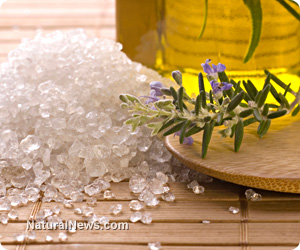
Lavender oil is for healing
Saturday, September 14, 2013 by: Willow Tohi
Tags: lavender oil, healing, essential oils
- Newly released JFK files reveal Pentagon's role in creating Lyme disease and covid in the same lab
- Trump nominates VACCINE ZEALOT Susan Monarez to lead the CDC, sidelining RFK Jr.'s reform efforts
- BEWARE: USDA allows genetically engineered vaccines to infiltrate organic food production
- Obama accused of laundering USAID funds to fuel global protest movements, regime change operations
- HUGE: Putin claims 2020 election fraud in U.S. sparked Ukraine war, calls for peace talks with Trump
- Chris Rufo finally reveals abuse liberals unleashed on his wife and young kids...
- Deep State in disarray: Trump's funding freeze sows chaos, Democrats vow legal battle
- Trump shows his true colors
- STARDUST, a secretive Israeli-US startup, plans risky solar geoengineering experiment to BLOCK OUT THE SUN
- $2B Roundup verdict: A landmark blow to Bayer and a win for health freedom
- Trump's greatest betrayal so far: Accelerating Middle East wars, silencing dissent, and serving Zionist masters
- Outrageous government fraud: $312M in COVID loans went to children as young as 9 months old
- Festive flavors: The sweet history, nutritional profile and health benefits of pecan pie
- “Behind the Green Mask”: Rosa Koire exposes the hidden agenda of UN Agenda 21
- SWEET SABOTAGE: CIA's secret war on Soviet sugar revealed in JFK files
- Dr. Mike Yeadon releases 15-minute testimony - WATCH - about genocidal intent of COVID “vaccines”
- “Forever chemicals” in drinking water drive alarming cancer surge, new study warns
- A mysterious startup is developing a new form of solar geoengineering
- Elon Musk: Aliens could be here on Earth RIGHT NOW
- EPA advisor admits the agency is funneling billions to climate groups ahead of Trump’s return to White House
- Trump reverses course on Gaza plan, says “nobody is expelling Palestinians”
- Reclaim your health: How midlife exercise reverses years of inactivity
- A lack of integrity in Academia: Harvard professor found GUILTY of fraudulent research to promote CRT theory
- Space war brewing? Russia threatens to destroy Starlink satellites
- Big Pharma's $8 Billion bribery scheme exposed: how doctors are pushed to prescribe junk science, not heal
- Mike Adams Sermon 66: God will DESTROY ISRAEL for its wickedness
- Rep. Nancy Mace introduces bill to ban biological males from female facilities on federal property
- Survival 101: Effective EMF blocking techniques
- 5 Simple steps to boost your brainpower: How to strengthen executive function in a distracted world
- Historian warns Israel may be entering an “IRREMEDIABLE DECLINE”
- Florida takes a stand: DeSantis proposes permanent ban on mRNA vaccine mandates
- RFK Jr.'s SSRI antidepressant investigation sparks liberal meltdown, exposes Big Pharma's dangerous game
- New York politicians push bill allowing governor to indefinitely detain the unvaccinated on a whim
- Sales of survival bunkers rise following Russia’s use of the Oreshnik hypersonic ballistic missile
- Pilots report mysterious lights 'moving at extreme speeds' across Oregon skies
- Newly released JFK files reveal Pentagon's role in creating Lyme disease and covid in the same lab
- EPA advisor admits the agency is funneling billions to climate groups ahead of Trump’s return to White House
- The Health Ranger releases “Vaccine Zombie” song and music video, using AI-animated zombies for the music video
- The pandemic as a tool for INDOCTRINATION: Understanding “The Indoctrinated Brain” by Dr. Michael Nehls
- California's social media censorship law struck down: A victory for free speech or a threat to online safety?
- Dr. Mike Yeadon releases 15-minute testimony - WATCH - about genocidal intent of COVID “vaccines”
- Congratulations to the FULLY UNVACCINATED as you resisted the COVID-19 PROPAGANDA MACHINE fueled by over $100 BILLION
- Mike Adams releases country western hit single: Goin’ Back in Time is Comin’ Home
- RFK Jr. clears key hurdle: Sen. Susan Collins backs controversial HHS nominee, signaling a new era for health policy
- Mike Adams releases music poetry sensation: A Child of God
- Mike Adams releases new song and music video: Nothing More Disgusting Than a Globalist
- Unpacking the Lies That We’ve Been Fed – new song and music video released by Mike Adams, the Health Ranger
- Trump administration takes on global censorship: A new frontier for free speech advocacy
- Florida takes a stand: DeSantis proposes permanent ban on mRNA vaccine mandates
- “Why we influenced the 2020 elections”: Facebook files reveal the coordinated effort to bury the Hunter Biden laptop story
- Ex-FBI Chief EXPOSES disgraceful government coverups of Oklahoma City Bombing, Kennedy assassinations, 9/11 WTC, and "Terrorism" as plot to destroy Constitution
- Michigan sheriff announces criminal investigation into 2020 election crimes, Dominion Voting Systems
- Israeli soldiers accused of even more torture and abuse in the West Bank
- Federal judge backs Trump's mass firings, clearing path for government downsizing
- Red Cross issues warning to stop blood plasma donations from vaccinated people
- Scientists confirm: GENIUS brain function can be spontaneously unleashed in humans without any apparent cause
- EPA advisor admits the agency is funneling billions to climate groups ahead of Trump’s return to White House
- HYSSOP: What research reveals about the health benefits of this ancient holy herb
- Two containers with completed ballots fall out of truck in Florida
- Fully vaccinated about to see “tsunami” of illness and death, warns virologist
- Today I asked our AI language model “Neo” about which phytonutrients or phytochemicals can block the spike protein related to SARS-CoV-2 … Here is what it answered…
- Global leaders unite to clamp down on “misinformation” with UN-backed Cascais Declaration
- BREAKING: 2025 NDAA authorizes mandatory military draft of WOMEN across America… as Pentagon pursues global NUCLEAR war with both Russia and China at the same time
- Michael Yon warns of a ZIONIST TAKEOVER in Trump’s second administration
- BOMBSHELL: DNA testing kits are a SCAM to develop ethnic-specific bioweapons
- Ozempic and Wegovy weight loss drugs are injectable LIZARD VENOM PEPTIDES that may unleash a devastating wave of organ failure… side effects align with symptoms of SNAKE BITES
- Israeli soldiers accused of even more torture and abuse in the West Bank
- These 13 countries just signed an agreement to engineer a global FAMINE by destroying food supply
- NASA admits that climate change occurs because of changes in Earth’s solar orbit, and NOT because of SUVs and fossil fuels
- RFK Jr. clears key hurdle: Sen. Susan Collins backs controversial HHS nominee, signaling a new era for health policy
- Sermon 30: How Jesus reveals Caesar’s FAKE CURRENCY and FALSE AUTHORITY
- Coriander seeds: Ancient medicine backed by modern science
Essential oils come from the natural aromatic liquids found in plants, trees, and shrubs. The distinctive components that defend a plant against insects, environmental pollutants and disease, and allow it to grow and adapt to its surroundings, make up the plant's essence. The essence is extracted from the plant's flowers, leaves, roots, seeds, or peels into a concentrated volatile liquid, most often through steam distillation. They are highly concentrated and more potent than any dried herb. Essential oils will strengthen most holistic programs, including herbal and nutritional supplements.
The best-known healing oil
Lavender essential oil has many wonderful uses. One of the best known healing oils, lavender oil has a chemically complex structure with over 150 active constituents, which explains its effectiveness at helping with everything from insect bites to rheumatism. The botanical name, Lavandula, comes from Latin, lavare, which means "to wash," probably for its history of use cleansing wounds, as well as washing linens and in personal bathing. It is a known anti-inflammatory, anti-fungal, antidepressant, antiseptic, antibacterial, antimicrobial, antispasmodic, analgesic, calmative, detoxifier, hypotensive, and sedative.Among the most versatile of oils, lavender is very effective at soothing, calming, balancing (both mind and body), and revitalizing. It is used through inhalation, massage, bath or shower, humidifier or vaporizer, or added to skin and personal care products. Your female ancestors most likely used lavender water as perfume. It is good for all skin types including sensitive skin, unless the scent puts you off - this seems to be a built-in warning system useful for gauging your compatibility with all the essential oils. Too much can be toxic to any system, so obey your nose and avoid it if you don't care for the smell.
Uses
Lavender oil has a well documented history of effectively treating burns and scalds. It's pain relieving properties, combined with its antibacterial and antiseptic properties make it an effective wound treatment that stimulates the cells of a wound to regenerate more quickly, and prevent scarring. It is useful for treating headaches, insomnia, fever blisters, acne, anxiety, stress, and depression. Additional uses include:• Apply lavender oil to insect bites, including bee and wasp stings, to neutralize pain and swelling almost immediately
• Mix with aloe vera to treat sunburns
• A cool compress on the forehead with lavender eases sinus headaches
• Add it to shampoos to prevent dandruff and reduce hair loss
• Lavender in your linen closet repels moths
• Add a few drops to the rinse water to give your laundry a good smell
• It is a great room deodorizer; add to potpourri
• A drop or two on a pillow or pajamas will encourage sleep
• Lavender in bath water will help relax children for bedtime
• Place leaves and flowers in sachets for your underwear drawer
• It can be used to treat urinary tract, bladder, and yeast infections
• Lavender is an effective at-home treatment for athlete's foot and other fungal infections
• It eases coughs and colds, and reduces fever
• Lavender can be used to treat animals for fleas
• It is an effective treatment for head lice
• Lavender stimulates growth of healthy new cells
• Add a few drops of oil to unscented lotion or make your own perfume water for a nice, clean personal scent
• Lavender is useful in easing motion sickness and high blood pressure
• A couple drops on a cotton ball in the bottom of a trash can or diaper pail helps neutralize odors
• Add a few drops to a carrier oil - something in your kitchen will probably work, such as olive or almond - for a massage of muscles or joints
Lavender also combines well with several other oils to make nice blends, which extends its usefulness. For example, mix with grapefruit or eucalyptus for insect repellent.
Lavender, the plant and its oil, has been used continuously for thousands of years and is native to the Mediterranean. There are several varieties, and they grow at varying altitudes. The finest, which is for medicinal use, grows at higher altitudes, making it more difficult to cultivate, which in turn makes it more expensive. The more common and available lavender is best for most users and uses. For around $15 you can have a great addition to your at-home health cabinet. As you only need a drop or two for most uses it will last a long time. For access to the plant itself, lavender is widely grown today and there are many 'pick your own' farms here in the U.S. There are probably plants for sale at your local nursery if you'd like to grow your own.
Rules for use
Essential oils should not be applied directly to the skin in their concentrated, undiluted form. They are not for internal use, unless under the care of a qualified practitioner. Avoid contact with eyes and mucous membranes. Keep out of reach of children and pets. Always store oils tightly closed in a cool, dark place as they are sensitive to heat and light. If they are in dark glass bottles, they should keep for a long time if stored properly. Do not use in conjunction with flower essences or homeopathy without guidance. Several oils should be avoided during the first trimesters of pregnancy and by those with conditions such as high blood pressure or epilepsy, again, unless under the care of a qualified aromatherapist. Sensitivity or even allergy to essential oils is possible, so trust your instincts - and your nose.Essential oils are powerful, ancient medicine. Today, they are also readily available in less volatile varieties for ease of use by laypeople for topical and everyday purposes. There are lots of recipes online, or pick up a good book on essential oils. You'll probably save yourself some money and some exposure to the chemicals in most personal care products and topical treatments.
Sources for this article include:
http://www.organicfacts.net
http://www.youngliving.com/en_US/wellness/about-essential-oils/
Worwood, Valerie Ann. The Complete Book of Essential Oils & Aromatherapy. New World Library, San Rafael, CA, 1991. P. 19-20.
Fischer-Rizzi, Susanne. Complete Aromatherapy Handbook. Sterling Publishing Co, New York 1990. p. 110-117
Davis, Patricia. An A-Z Aromatherapy. Barnes and Noble Books, New York 1995. P. 183-187.
Lavender oil at FETCH.news
Get independent news alerts on natural cures, food lab tests, cannabis medicine, science, robotics, drones, privacy and more.
Take Action: Support Natural News by linking to this article from your website
Permalink to this article:
Embed article link: (copy HTML code below):
Reprinting this article:
Non-commercial use OK, cite NaturalNews.com with clickable link.
Follow Natural News on Facebook, Twitter, Google Plus, and Pinterest
Science News & Studies
Medicine News and Information
Food News & Studies
Health News & Studies
Herbs News & Information
Pollution News & Studies
Cancer News & Studies
Climate News & Studies
Survival News & Information
Gear News & Information
News covering technology, stocks, hackers, and more



"Big Tech and mainstream media are constantly trying to silence the independent voices that dare to bring you the truth about toxic food ingredients, dangerous medications and the failed, fraudulent science of the profit-driven medical establishment.
Email is one of the best ways to make sure you stay informed, without the censorship of the tech giants (Google, Apple, Facebook, Twitter, YouTube, etc.). Stay informed and you'll even likely learn information that may help save your own life."
–The Health Ranger, Mike Adams













































